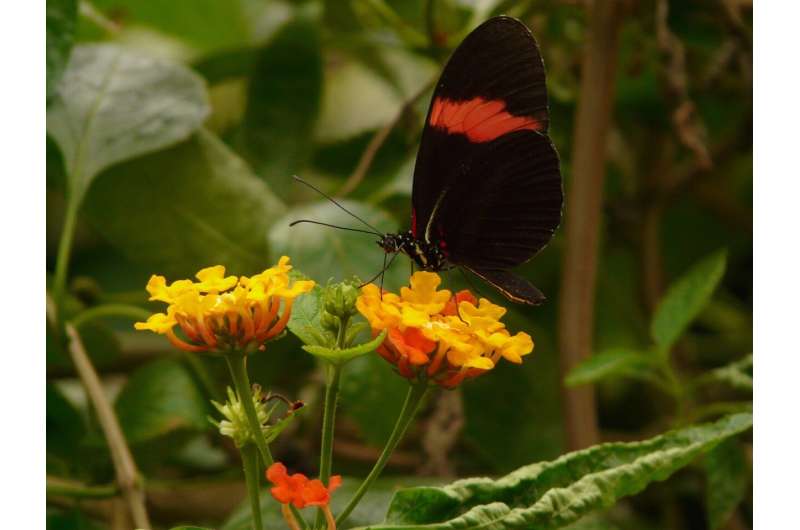This article has been reviewed according to Science X's editorial process and policies. Editors have highlighted the following attributes while ensuring the content's credibility:
fact-checked
peer-reviewed publication
trusted source
proofread
Butterflies mimic each other's flight behavior to avoid predators, show scientists

Researchers have shown that inedible species of butterfly that mimic each others' color patterns have also evolved similar flight behaviors to warn predators and avoid being eaten.
It is well known that many inedible species of butterfly have evolved near identical color patterns, which act as warning signals to predators so the butterflies avoid being eaten.
Researchers have now shown that these butterflies have not only evolved similar color patterns, but that they have also evolved similar flight behaviors, which together make a more effective warning signal to predators. The article is published in the journal Proceedings of the National Academy of Sciences.
Using high-speed video footage to record the flight of wild butterflies in South America, researchers at the University of York measured the wing beat frequency and wing angles of 351 butterflies, representing 38 species each belonging to one of 10 distinct color pattern mimicry groups.
Using this dataset they investigated how the flight patterns of butterflies are related to factors such as habitat, wing shape, temperature and which color pattern mimicry group the butterfly belongs to see which elements most heavily affected flight behavior.
Although the species habitat and wing shape were expected to have the greatest influence on flight behavior, the researchers found that in fact the biggest determinant of flight behavior was the color pattern mimicry group a butterfly belonged to.
This means that distantly-related butterflies belonging to the same color pattern mimicry group have more similar flight behavior than closely-related species that display different warning coloration. To a predator, the butterflies would not only look the same through their color patterns, but would also move in the same way.
Edd Page, Ph.D. student from the Department of Biology at the University of York and one of the lead authors of the study, said, "From an evolutionary perspective it makes sense to share the color pattern between species, to reduce the individual cost of educating predators to the fact that they don't taste nice.
"Once a predator has tasted one, the visual clues on others indicate that they too are also inedible, but flight patterns are more complex and are influenced by several other factors such as the air temperature and the habitat the species fly in.
"We wanted to see whether flight corresponded to color—could predators be driving the mimicry of flight as well as color patterns? We were surprised to find just how strong and widespread the behavioral mimicry is."
The team looked specifically at a tribe of butterflies called the Heliconiini, which have around 100 species and subspecies distributed around the Neotropics, each belonging to one of several distinct color pattern mimicry groups.
They also investigated a few species from the ithomiine butterfly tribe, which split from the Heliconiini about 70 million years ago, yet some of whom have very similar "Tiger" color patterns.
Edd said, "Sharing flight behavior across multiple species seems to reinforce this 'don't eat me' message. It is fascinating that this behavior has evolved between distant relatives over a long period of time, but we can also see flight behavior diverging between differently patterned populations within a species over a relatively short period of time too."
Professor Kanchon Dasmahapatra, from the University of York's Department of Biology, said, "The extent of flight mimicry in this group of butterflies is amazing. It is a great example of how evolution shapes behavior, with selection from predators driving subtle changes which enhance the survival of individuals.
"The challenge and interest now is to identify the genes causing these changes, which will tell us how such behavioral mimicry evolves."
More information: Page, Edward et al, Pervasive mimicry in flight behavior among aposematic butterflies, Proceedings of the National Academy of Sciences (2024). DOI: 10.1073/pnas.2300886121. doi.org/10.1073/pnas.2300886121
Journal information: Proceedings of the National Academy of Sciences
Provided by University of York




















